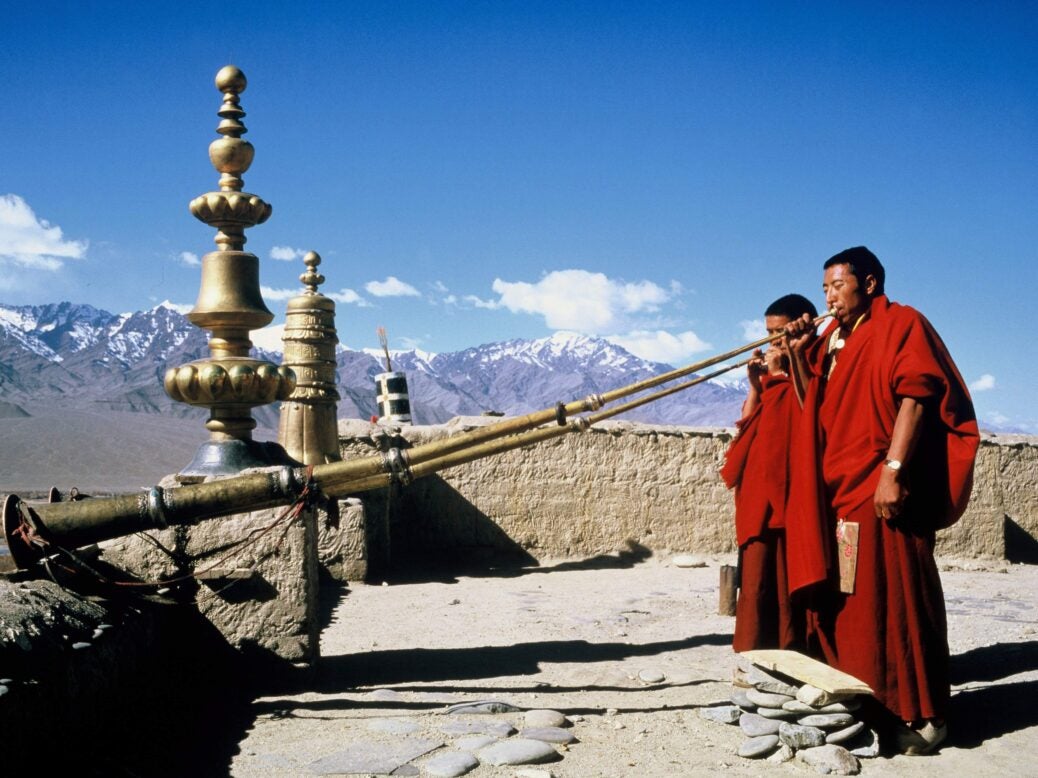
Matthew Hardeman passes through one of the world’s highest airports for the ultimate Himalayan experience: Shakti Ladakh
Typically the preserve of crusty backpackers and death-defying, ice-picking mountaineers, to think of a week or two in the Himalayas is to think of breathtaking vistas and peerless skies on Everest. That means oxygen tanks, ten layers of Gore-Tex and tiny tents pitted against the elements, perched precariously on a mountainside. Not everyone’s cup of Chai, to be sure.
At least that’s how it used to be. Fortunately, a handful of intrepid and discerning travel companies stepped into the void – fewer still into the remote, inaccessible (and politically sensitive) environs of Ladakh – often referred to as ‘Little Tibet’. Eleven thousand five hundred feet up, sandwiched between Pakistan and China in India’s furthest north, the region lies on the high plateau where, in 1948, an airport was built before any roads (local folklore says Ladakhi villagers hauled alfafa and grass to the airstrip upon sight of the first aircraft, thinking it was a giant, hungry bird).
One imagines such a creature would be just as beguiled, circling above 45,000 square kilometres of high desert with its rugged snow-capped mountains and deep azure lakes; as I was when I visited in September. Certainly, to gaze out the window on the flight from Delhi at the lush green foothills of Himachal Pradesh, rising and morphing into the stark brown moonscape of Ladakh is to look upon the face of another world. Landing at Leh, the area’s main city and nearest airport (it’s also the world’s highest), a vast range of white-peaked mountains towers over small green village pastures, clinging to life through its rivers which soon give way again to epic stretches of arid and scrawling landscape that looks more like Mars than anywhere on earth.

There’s just as much drama and intrigue to be found in Ladakh’s political geography: following independence from Britain, Ladakh, like Kashmir was divided, the majority of which became Indian-administered Kashmir. Already a geopolitical hot-zone due to the line of control (the de-facto India-Pakistan border) which runs through it, tension in Ladakh spiked again as China occupied Aksai Chin – claimed by India – to the east of Ladakh, leading to the 1962 Sino-Indian war. Critically, the region and its Tantric Buddhist society were shielded from the ruin of the Chinese Cultural Revolution, leaving its culture intact like few others can claim.
To look around, it makes sense that few entrepreneurial travellers came here with lofty ideas of luxury – not least the wherewithal – before Jamshyd Sethna, who, through his company Shakti, developed the idea of high-end travel on the high plateau of the Indian Himalayas with his series of village walks. His guests enjoy a different experience: that of rural life in the remote mountain regions, in comfort, and without any of the nitty gritty arrangements and effort.
There’s no tenting at Shakti, unless you want to, of course. Instead, nights are spent in a local collection of traditional village houses (a night or two is typically spent in each as you move around), each with their own guest areas serviced by local, live-in staff. Renovated every year, each retains the local look and feel too, with a healthy dose of boho-chic (the sophisticated, not-wannabe kind) and a sense of simplicity that emphasises what’s going on outside more than in.
Rakish and charming, Sethna, a Parsi from Bombay, discovered his love of the mountains at the prestigious St Paul’s school in Darjeeling in the shadow of Kangchenjunga, and as a young tea planter in Upper Assam. Through the success of Shakti’s sister company, Banyan Tours, he founded Shakti in 2004 to revamp the Himalayas experience for luxury travellers through its series of short, village-to-village treks – the first being the Shakti Village Walk, in the Kumaoni foothills of the western Himalayas. The second walk was established in Sikkim in 2006, and its collection has grown slowly but deliberately ever since – from Leti in Sikkim to Nimmoo in the Nubra Valley (good luck finding them on any maps), and Shakti’s latest foray, Shakti Ladakh, in the country’s remotest north.
We went to visit the house in Ladakh after sailing down through the valley’s more hair-raising, newly-carved mountain roadways (courtesy of a major infusion of cash and ambition by the Indian government) with our charming guide Rohan, (another St Paul’s graduate), whizzing past shrines, stone cairns, stupas and ancient prayer wheels, while colorful prayer flags continually flutter and snap against the deep blue sky just about anywhere they can be planted.
The scene that greets us is ethereal, unblemished by time and modernity. Lush green valley plains and a handful of small white village houses dot the banks of the winding river Indus. Locals tend to their crops below in traditional dress and method, unchanged for hundreds of years. In the background, the arid, soaring face of the Himalayas glows red in the sun as it dips beyond the horizon.
Shakti’s porters greet us with cool towels and cardamom-infused juices are taken as we peek around the place, dabbing apricot oil and lip balm to vanquish the dry air. Poplar beams and willow twigs crisscross the roof above tasteful, rustic furniture, while floor-to-ceiling glass windows offer impeccable views of the mountains and the quiet village life down in the valley plain. There are soft cotton sheets and down pillows, sleek wood and stone bathrooms, to enjoy, stylish walk-in showers and an outdoor seating area, again offering panoramic vistas.
It’s easy to feel hungry up here, with all the extra altitude and exertion, but fortunately the cuisine at Shakti is nothing short of remarkable. Its guests certainly aren’t treated to any of the grim grub typically associated with this harsh and unforgiving landscape, where the locals struggle to grow or transport the ingredients necessary to make anything more exciting. Instead, the cooks treat guests to sumptuous lamb curries and other Indian delicacies and breakfasts are a selection of healthy cereals, pomegranates and eggs, cooked to perfection. Even the wine is something to behold, but there are no French or Italian sommeliers here, and quite deliberately too. Guests are waited on by teams of working-class locals, who attend to guests impeccably, but from a discreet distance.
It should be no surprise that Shakti’s clientele comes just as refined. Lords and Ladies have signed up to its village walks, and at least one Hollywood A-lister is said to have proposed to on one its hilltops, according to a source. Not that you’d run into another party yourself, of course. All itineraries are tailor-made for each guest (you might bump into a westerner or two at monasteries like Likhir and Hemis – the largest and most famous – which are seldom spared at least a few tourists). All the while, it’s just you the guest, your guide, Shakti’s live-in team, and the locals – virtually all of whom we meet turn to greet us with a smile and cheerful ‘Juley’ (the magic word in Ladakh, meaning everything from hello onwards). Everyone else up here, it seems, is a Buddhist monk or Indian Army – and you are bound to see many of them. Indeed, 75 per cent of the Indian military are stationed here in Jammu and Kashmir, thanks to China and Pakistan’s colourful approach to territorial disputes in the past. It’s a constant and actually quite pleasing reminder that indeed, you are really travelling – not riding a tourist circuit in the usual safety and certainty.
While there’s plenty of downtime to enjoy each day (indeed, it’s rather recommended – same goes for the endless picture-perfect moments) there’s no shortage of times where you’ll want your camera stashed safely away: from an incredible hair-raising bike-ride down from the valley’s peak all the way past ancient monasteries and army installations, to white-water rafting (and swimming further down) on the Zanskar river: a real highlight, although I’ve never seen anyone look as terrified as our companion who fell in, and who apparently has never been wet before. I’m glad to say we rescued the poor chap, to much fanfare.
Of course, you might expect gentler moments, just as indelible. Our stays at the river houses, and the Likhir village house and its views of the Nubra valley, its flowers and winter’s first snow. The visits we paid to the ancient Buddhist monasteries was a rare privilege – the most memorable of which was full of young monks aged six and above, chanting through their morning prayers and ancient rituals in a Tibetan trance, all glances and smiles under the austere gaze of their masters, resplendent in their deep red robes. I won’t soon forget discussing the ways of the world with a Buddhist monk, or our visit to the coppersmiths of Chilling, whose ways have hardly changed for hundreds of years – or the laughter and late night games of Scrabble, sipping gin by the fire in a cosy little library after dinner and gazing up at shooting stars and the Milky Way like you won’t see them anywhere else.

Back in New Delhi surrounded by the unbounded luxury of the Lodhi presidential suite, perched on the edge of the plunge pool balcony and looking out at the mad hustle and bustle of this mystical city (not to mention a re-connected phone blowing up with emails), a sense of great blessing still prevails. Those who have experienced Ladakh’s cloud kingdom as we have, are part of a small and privileged club; it is a land as real as it is magical, with its unique and ancient history; intrigue and untamed wilderness.
Keep your icepicks. I’ll take the heights of luxury over a crevasse on Everest any day.
Black Tomato (www.blacktomato.com, 0207 426 9888) can arrange eight-night luxury trips to Ladakh, India from £5,700 per person based on two sharing, including private full board accommodation at the Shakti Ladakh village houses and a night at The Lodhi in New Delhi on bed and breakfast basis; internal and international flights from London; private guides and activities; and private transfers.












